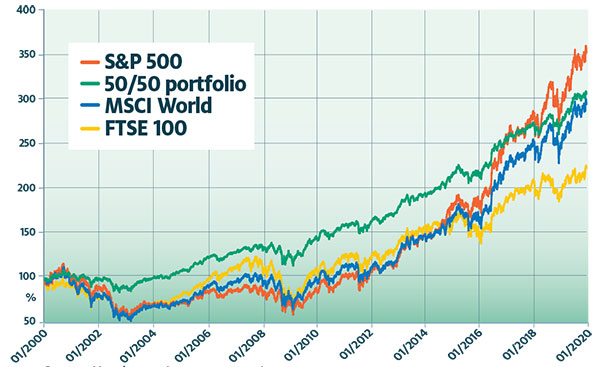How to build an all-weather ETF portfolio in three steps
A balanced ETF strategy can buttress portfolios in turbulent times.
27th July 2020 14:52
A balanced ETF strategy can buttress portfolios in turbulent times.

For investors with moderate risk tolerance, using passive funds to build a portfolio balanced between capital preservation and growth can be a good option. Dividing assets equally between diversified stock and bond ETFs can protect investors from unfavourable market movements in the short term, while offering good long-term growth potential.
For example, a very simple balanced portfolio split 50/50 between two global stock and bond ETFs has delivered higher returns than key equity market indices such as the MSCI World and the FTSE 100 over the 20 years to January 2020. In fact, even the phenomenal bull run of the S&P 500 since 2009 would have only placed the US equity index just above the returns delivered by the 50/50 portfolio (see chart). The real benefit of diversification has been to protect on the downside. This was particularly evident during the early 2000s tech crash and the financial crisis in 2008.
The portfolio’s ability to shelter capital has come to the fore once again during the current market volatility caused by the coronavirus pandemic. While the FTSE 100 and the S&P 500 plummeted by around 30% and 15%, respectively, in a matter of weeks in February and March, this balanced investment strategy limited the fall to just 10%, even though quite substantial jitters have been felt in international bond markets.
Here is a three-step guide to building and monitoring this simple ETF portfolio.
Step one: pick your equity ETF
For the equity allocation, investors could consider the Vanguard FTSE Developed World ETF (VEVE) or Lyxor Core MSCI World (LCWL). They are broad and diversified ETFs that blanket nearly every developed country stock. Currently, the US accounts for 60%-65% of the index, followed by Japan (8%-10%), the UK (5%-7%), and France (3%-5%).
These ETFs also offer balanced sector exposure, led by financial services and technology, healthcare and industrials (at the time of this review). Portfolio concentration is very limited, with the top 10 holdings accounting for around 15% of the index. The ongoing charges of just 0.12% are the lowest in their passive ETF peer group.
Step two: pick your bond ETF
For the bond allocation, investors could opt for the SPDR Global Aggregate Bond ETF (SPFB) or iShares Core Global Aggregate Bond UCITS (AGBP). Both track the Bloomberg Barclays Global Aggregate Bond index and come with an ongoing charge of 0.1%. Holdings include a broad range of investment-grade government, supranational, corporate and securitised bonds from a large number of developed and emerging economies.
Both ETFs also come with the advantage of a hedge-to-sterling version, which can mitigate the impact of short-term currency movements. There are also unhedged versions to suit the varying needs of investors in Europe, the Middle East and Africa and their attitudes to foreign exchange risk.
US issuers account for around 40% of the index. Japan follows with just over 15%, and France, Germany and the UK account for around 5% each. The combined weight of emerging market issuers is 10%.
Step three: rebalance
Rebalancing the portfolio in order to keep the targeted 50/50 allocation is crucial because it helps control risk. It involves selling investments from the ETF that has outperformed and reinvesting the proceeds into the other ETF. Typically, in periods of strong market performance the weight of the equity ETF will grow larger, while in times of crisis its value will drop.
Failing to rebalance is likely to result in increased risk if the equity allocation’s weight increases, or limited returns if the weight of the bond allocation rises too high. However, rebalancing should not be done too frequently, as it raises trading costs. For an investor with a moderate risk threshold, sticking to a simple 10% buffer will likely suffice. This means that once the weight of one of the ETFs is 10% over the desired 50% allocation, the weightings should be equalised. Investors with higher risk tolerance may set this buffer higher.
A 50/50 equity/bond ETF strategy has been highly rewarding over the past 20 years

Source: Morningstar, January 2000 to January 2020.
Dimitar Boyadzhiev is a senior analyst, manager research, passive strategies, at Morningstar.
This article was originally published in our sister magazine Money Observer, which ceased publication in August 2020.
These articles are provided for information purposes only. Occasionally, an opinion about whether to buy or sell a specific investment may be provided by third parties. The content is not intended to be a personal recommendation to buy or sell any financial instrument or product, or to adopt any investment strategy as it is not provided based on an assessment of your investing knowledge and experience, your financial situation or your investment objectives. The value of your investments, and the income derived from them, may go down as well as up. You may not get back all the money that you invest. The investments referred to in this article may not be suitable for all investors, and if in doubt, an investor should seek advice from a qualified investment adviser.
Full performance can be found on the company or index summary page on the interactive investor website. Simply click on the company's or index name highlighted in the article.